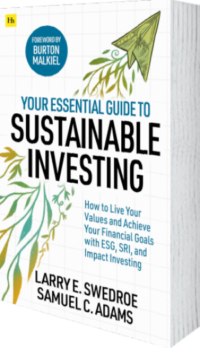My first experience with sustainable investing was over 20 years ago, and I can classify my experience in a single word: confusing. I was a research assistant for a Wharton professor – Chris Geczy – who was working on an academic paper, “Investing in Socially Responsible Mutual Funds” (eventually published in the Review of Asset Pricing Studies). My job was to hand collect the data from an ad hoc assortment of databases and qualitative resources to determine which funds should be designated “socially responsible.” The job was incredibly challenging because there was no classification guidebook. The job left me disillusioned with socially responsible, sustainable, ESG, impact investing – and whatever other words people used to identify this brand of investing. Yuck!
Fast forward 20 years. I still consider the sustainable investing category confusing. However, Larry Swedroe and Sam Adams’ new book, Your Essential Guide to Sustainable Investing, solved my problem.
Sustainable investing is no longer confusing.
Swedroe is a prolific author who has written 17 books and thousands of articles on investments and financial planning. He serves as the chief research officer at Buckingham Strategic Wealth.
Adams is an expert in making sustainable investing more accessible for investment and financial-planning professionals. Sam spent almost two decades with Dimensional Fund Advisors and is currently the CEO of Vert Asset management.

- Larry Swedroe and Sam Adams
- The book can be found here.
- Want to see all our book reviews?
What did I like about the book?
What I liked about this book is the following:
- Well-organized and accessible content;
- Clarification of the confusion surrounding sustainable investing; and
- A comprehensive, evidence-based view of the topic.
The book’s organization is well structured and easy to follow. The chapters are outlined as follows and serve as an excellent reference list if the reader wants to access a specific topic quickly:
- What is sustainable investing?
- Methods of sustainable investing
- Who is investing for sustainability?
- Exploring motivations
- The evolution of ESG investing
- The performance of ESG investing
- The impact of sustainable investing
- How to invest sustainably
Appendix: Numerous topics are covered.
Larry and Sam provide tangible categories of sustainable investing. They will allow advisors to think more clearly about this investing discipline.
The authors break sustainable investing into three camps:
- Impact investing
- Socially responsible investing
- ESG investing
These camps are viewed through the lens by which they focus on financials versus societal impact. Impact investing leans towards making changes in society via investing, whereas ESG is primarily concerned with acknowledging and making better investment decisions via data and analytics.
My favorite part was the summary of academic research in chapters 6 and 7. Of course, if you know Swedroe’s prior work, you will expect a comprehensive review of the academic literature. The discussion of the previous research on sustainable investing is thorough and fair. The authors highlight research that was not entirely positive on the investing category. They suggest that the expected performance of sustainable investing might be lower than alternative approaches. And while many might consider this to be akin to throwing a cold, wet blanket on sustainable investing, the logic and review of the literature are intellectually honest.
On the flip side, the upside of potentially lower returns is evidence that the investor movement towards sustainability has forced companies to address ESG-related issues. Of course, the authors aptly highlight that this isn’t always the case, and there are a lot of suspect operators in the sustainable investing asset management business.
Constructive criticisms
My main critique of the book (ironically, also one of my favorite parts of the book) is the in-depth research chapters. The authors do a good job summarizing each paper and why it is essential; however, I was left looking for more analysis that tied the research together or focused on pieces where there was the most disagreement with the view that ESG- and sustainability-based investing is virtuous and profitable. Many readers will want 1) more analysis on papers that disagree the most with that view; and 2) readers will want the “answer” instead of being forced to come up with their own.
Another critique, albeit less critical, is the relatively thin appendix on implementation. I would have preferred to see a complete chapter on this topic with a more in-depth discussion on the nuts and bolts of implementing these strategies.
Summary
I am grateful for this book because I am less confused about sustainable investing, and I am inspired to learn more about the topic. I commend Larry and Sam’s work for being technically accurate and complete, while accessible to a reader who isn’t an expert on the subject and is looking to learn more.
About the Author: Wesley Gray, PhD
—
Important Disclosures
For informational and educational purposes only and should not be construed as specific investment, accounting, legal, or tax advice. Certain information is deemed to be reliable, but its accuracy and completeness cannot be guaranteed. Third party information may become outdated or otherwise superseded without notice. Neither the Securities and Exchange Commission (SEC) nor any other federal or state agency has approved, determined the accuracy, or confirmed the adequacy of this article.
The views and opinions expressed herein are those of the author and do not necessarily reflect the views of Alpha Architect, its affiliates or its employees. Our full disclosures are available here. Definitions of common statistics used in our analysis are available here (towards the bottom).
Join thousands of other readers and subscribe to our blog.

